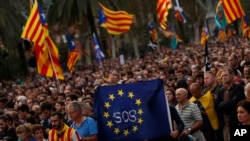The standoff between Spain and Catalonia entered a new phase on Tuesday as Catalonia's leader delayed by several weeks a formal declaration of independence from Spain.
The current political crisis could now take several paths.
Government response
Prime Minister Mariano Rajoy has called an emergency Cabinet meeting for Wednesday to decide the Spanish government’s response to the declaration. Rajoy had a meeting with his main rival, Socialist leader Pedro Sanchez, late on Tuesday.
He could deploy the “nuclear option” — an article of the constitution which enables him to sack the regional government and call an election.
Before resorting to this option, which has never been used, Rajoy’s government could call a parliamentary vote on whether to try to persuade Catalan leader Carles Puigdemont to abandon the
independence drive.
Rajoy is also scheduled to speak at an extraordinary session of the Spanish parliament at 4 p.m. local time (1400 GMT).
Whichever way he turns, Rajoy is likely to face criticism, either for clamping down too fiercely or for not pushing a hard enough line against separatism.
Another possibility is that the judiciary steps in, with the public prosecutor calling Puigdemont and other politicians to Madrid to testify.
Dialogue
A genuine dialogue between the Spanish and Catalan authorities to resolve the standoff remains highly unlikely.
Puigdemont and other regional politicians signed a document on Tuesday proclaiming “full sovereignty” for Catalonia, but it was unclear whether the move had any legal value.
Puigdemont said he was suspending the effects of a declaration of Catalan independence to allow time for dialogue.
But the central government immediately responded that any dialogue would have to take place “within the law” and said Puigdemont did not have the right to demand talks.
Meanwhile, far-left group CUP said the ball was in the Madrid government's court and Rajoy should be the one taking a step in their direction.
Formal declaration of independence
Tuesday’s declaration was largely symbolic because it was not formally endorsed by the regional parliament.
The anti-capitalist Popular Unity Candidacy (CUP), whose influence is disproportionate to its small size, insists a vote should take place, as stated in the Catalan law.
While it has for now maintained its support for the regional government, it said it had set a one-month deadline for talks.
If talks fail to happen, the CUP and another pro-independence party, Junts pel Si, are likely to ask the Catalan parliament to formally endorse Tuesday’s declaration of independence.
This declaration would be immediately blocked by Spain’s constitutional court and force the Spanish government to step up further its legal and political response to the crisis.
Regional election
If talks do not happen and a declaration of independence is not put to a vote in the Catalan parliament, the CUP could withdraw its support, triggering a regional election.
This election could also be called by Puigdemont himself to back up his weakened position or by the Madrid government if it considers Puigdemont and the Catalan authorities have gone too far, for instance if they seek a formal declaration of independence in the regional parliament.








